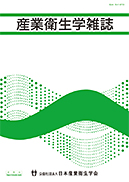
- |<
- <
- 1
- >
- >|
-
Hiromasa Ida, Kazumi Nakagawa, Asuka Tanoue, Kentarou Nakamura, Tatsuy ...2017 Volume 59 Issue 1 Pages 1-8
Published: January 20, 2017
Released on J-STAGE: January 31, 2017
Advance online publication: November 10, 2016JOURNAL FREE ACCESS FULL-TEXT HTMLObjective: Previous studies reported that presenteeism costs the enterprises more than absenteeism. It becomes more important for corporate management to evaluate the outcomes of health promotion initiatives for their employees using work performance scales in Japan. We previously developed a Japanese version of Work Limitations Questionnaire (WLQ-J), a presenteeism scale developed by Lerner D. et al., and conducted an internet survey to examine the reliability and validity of WLQ-J with 710 employees from an IT company and a medical institution as subjects and reported the study results (Ida et al, 2012). The objective of the present study is to examine the reliability and validity of WLQ-J with employees from more companies and industries than those included in the previous study. Methods: We analyzed for 4,440 employees from 14 companies and 9 industries as subjects, who were selected from a total of 4,712 employees who answered both WLQ-J and Brief Job Stress Questionnaire (BJSQ) on the internet or paper survey conducted from September 2014 to January 2015. Results: The subjects' average age was 40.3±11.8 years (33.2±9.5 years in the previous study), with the percentage of males and females being 77.9% and 21.1%, respectively. The factor structure of WLQ-J accorded with that of the original version of WLQ. This supports the factorial validity of WLQ-J. In addition, sufficient internal consistency was recognized by Cronbach's alpha of the whole scale (0.87 for the present study and 0.97 for the previous study) and the subscales (0.77-0.94 for the present study and 0.88-0.95 for the previous study). The four subscale scores of WLQ-J were significantly correlated with the stress response of BJSQ with correlation coefficients of 0.28-0.64 for the present study and 0.39-0.60 for the previous study (p < 0.01 for both studies). Moreover, criterion-related validity of WLQ-J was also supported by the significant dose-response relationship between the subscale scores of WLQ-J and stress response of BJSQ (p < 0.01 for the previous study and p < 0.001 for the present study). Conclusions: The present study demonstrated the reliability and validity of WLQ-J in a population of employees from more companies and industries than those in the previous study, with its average age and percentage of males and females close to those of the whole Japanese industries. This suggests that WLQ-J is available as a stable scale for presenteeism in different populations in Japan.
View full abstractDownload PDF (354K) Full view HTML -
Wakako Aoyama, Asami Tatsumi2017 Volume 59 Issue 1 Pages 9-18
Published: January 20, 2017
Released on J-STAGE: January 31, 2017
Advance online publication: November 15, 2016JOURNAL FREE ACCESS FULL-TEXT HTMLObjectives: In this study, concepts were constructed that express learning experiences in nursing master's degree programs utilized in occupational health nursing activities with the aim of clarifying those characteristics. This was based on the idea that elucidation of the characteristics of learning experiences in nursing master's degree programs used in occupational health nursing activities would be meaningful in providing high-quality occupational health services that respond to the needs of society. Methods: Semi-structured interviews were conducted with 10 people who fulfilled the three conditions of having completed a master's degree programs, working as an occupational health nurse after completion of the program, and not continuing on to a doctoral program. The nursing conceptualization method of Naomi Funashima was used. Results: From the obtained data, 512 code items expressing learning experiences in master's degree programs utilized in occupational health nursing activities were identified. These items included five core categories (concepts), 34 categories, and 69 subcategories. The five concepts constructed were "Pursuit of expertise and self-evaluation," "Mutual understanding of various people that leads to human resources utilization," "Theoretical and academic learning that influences changes in activities," "Research learning that lead to activities based on scientific evidence," and "Learning that leads to high-quality activities making use of expertise." Conclusions: It was found that various learning experiences in the master's program to pursue the specialty of occupational health nurses in order to recognize their roles as well as the experiences to take the initiative in learning had been integrated in their activities after completion of the course and had contributed to their high-quality occupational health nursing activities. It was suggested that the learning experiences in the master's program, which had been revealed in this study, were the experiences necessary for providing high-quality occupational health nursing activities to satisfy the social needs.
View full abstractDownload PDF (411K) Full view HTML
-
Jun Ojima2017 Volume 59 Issue 1 Pages 19-22
Published: January 20, 2017
Released on J-STAGE: January 31, 2017
Advance online publication: November 23, 2016JOURNAL FREE ACCESS FULL-TEXT HTMLDownload PDF (347K) Full view HTML
-
Teruyo Kitahara, Kazushi Taoda, Eiji Shibata, Ippei Mori2017 Volume 59 Issue 1 Pages 23-28
Published: January 20, 2017
Released on J-STAGE: January 31, 2017
Advance online publication: November 15, 2016JOURNAL FREE ACCESS FULL-TEXT HTMLDownload PDF (502K) Full view HTML
-
Takahiro Yamashita2017 Volume 59 Issue 1 Pages 29-33
Published: January 20, 2017
Released on J-STAGE: January 31, 2017
Advance online publication: November 23, 2016JOURNAL FREE ACCESS FULL-TEXT HTMLDownload PDF (261K) Full view HTML
- |<
- <
- 1
- >
- >|